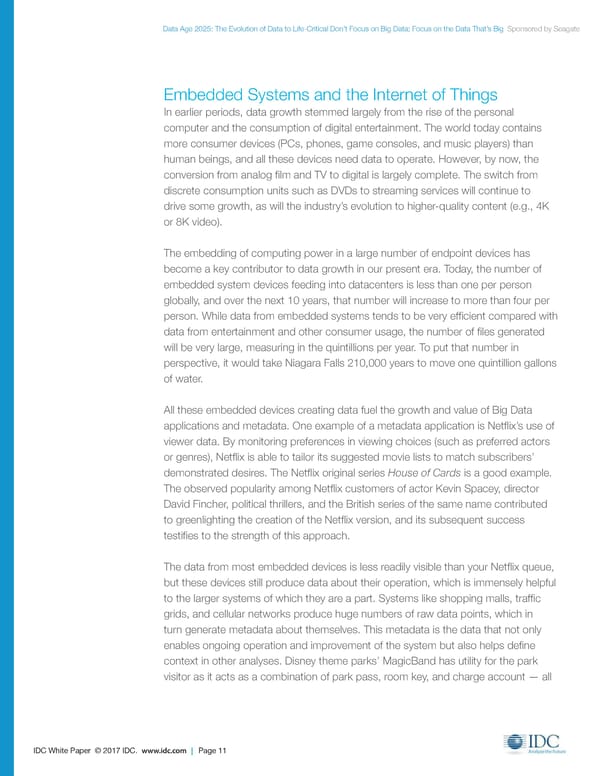Data Age 2025: The Evolution of Data to Life-Critical Don’t Focus on Big Data; Focus on the Data That’s Big Sponsored by Seagate Embedded Systems and the Internet of Things In earlier periods, data growth stemmed largely from the rise of the personal computer and the consumption of digital entertainment. The world today contains more consumer devices (PCs, phones, game consoles, and music players) than human beings, and all these devices need data to operate. However, by now, the conversion from analog film and TV to digital is largely complete. The switch from discrete consumption units such as DVDs to streaming services will continue to drive some growth, as will the industry’s evolution to higher-quality content (e.g., 4K or 8K video). The embedding of computing power in a large number of endpoint devices has become a key contributor to data growth in our present era. Today, the number of embedded system devices feeding into datacenters is less than one per person globally, and over the next 10 years, that number will increase to more than four per person. While data from embedded systems tends to be very efficient compared with data from entertainment and other consumer usage, the number of files generated will be very large, measuring in the quintillions per year. To put that number in perspective, it would take Niagara Falls 210,000 years to move one quintillion gallons of water. All these embedded devices creating data fuel the growth and value of Big Data applications and metadata. One example of a metadata application is Netflix’s use of viewer data. By monitoring preferences in viewing choices (such as preferred actors or genres), Netflix is able to tailor its suggested movie lists to match subscribers’ demonstrated desires. The Netflix original series House of Cards is a good example. The observed popularity among Netflix customers of actor Kevin Spacey, director David Fincher, political thrillers, and the British series of the same name contributed to greenlighting the creation of the Netflix version, and its subsequent success testifies to the strength of this approach. The data from most embedded devices is less readily visible than your Netflix queue, but these devices still produce data about their operation, which is immensely helpful to the larger systems of which they are a part. Systems like shopping malls, traffic grids, and cellular networks produce huge numbers of raw data points, which in turn generate metadata about themselves. This metadata is the data that not only enables ongoing operation and improvement of the system but also helps define context in other analyses. Disney theme parks’ MagicBand has utility for the park visitor as it acts as a combination of park pass, room key, and charge account — all IDC White Paper © 2017 IDC. www.idc.com | Page 11
 Data Age 2025: The Evolution of Data to Life-Critical Page 10 Page 12
Data Age 2025: The Evolution of Data to Life-Critical Page 10 Page 12